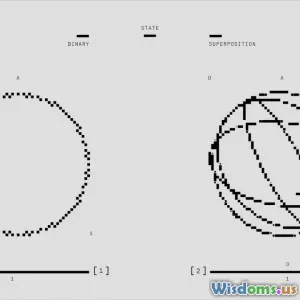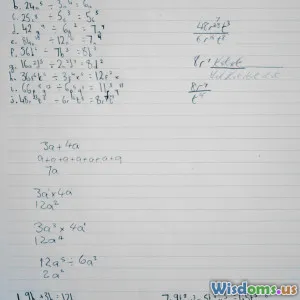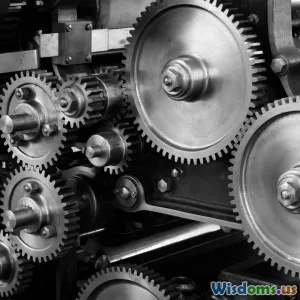
How Quantum Entanglement Is Shaping Future Computing
7 min read Explore how quantum entanglement is revolutionizing computing, unlocking unprecedented processing power and transforming technology's future. (0 Reviews)
How Quantum Entanglement Is Shaping Future Computing
Introduction
Imagine a world where computers solve complex problems in seconds that today’s fastest supercomputers would take millennia to crack. This isn’t speculative fiction—it’s the promise heralded by quantum computing, and at the core of this revolution lies a truly mind-bending phenomenon: quantum entanglement.
Quantum entanglement, famously described by Einstein as "spooky action at a distance," is the backbone of quantum mechanics that enables particles to be connected in such a way that the state of one instantly influences the state of another, regardless of distance. This article dives deep into how this strange quantum linkage is shaping the future of computing, revealing how entanglement empowers quantum processors, enhances security, and paves new paths for computation and communication.
Understanding Quantum Entanglement
Quantum entanglement occurs when two or more particles become intertwined such that the quantum state of each particle cannot be described independently of the others—even when separated by large distances. Consider two photons generated simultaneously: measuring the polarization of one immediately sets the polarization of the other, no matter how far apart they are.
This phenomenon defies classical intuition but is thoroughly validated by over 50 years of experiments, including recent loophole-free Bell test experiments. Entanglement challenges our understanding of locality and causality, hinting at a deeper underlying structure of reality.
Entanglement as a Computing Resource
Quantum Bits (Qubits) and Entanglement
Unlike classical bits, which can be either 0 or 1, qubits exploit superposition—holding states 0 and 1 simultaneously. However, superposition alone isn’t sufficiently powerful; it’s entanglement that enables quantum computers to process vast complexities.
When multiple qubits become entangled, the system can represent an exponentially large number of states simultaneously. For example, 10 entangled qubits represent 2^{10} or 1024 states simultaneously—offering dramatic speedups for certain computations.
Quantum Gates and Entangling Operations
Quantum computers manipulate entangled qubits using entangling gates such as the Controlled-NOT (CNOT) gate. These gates create correlations necessary to perform multi-qubit computations. For instance, Shor’s algorithm for integer factorization—capable of cracking RSA encryption—relies heavily on entanglement to exponentially reduce the time required.
Real-World Example: Google's Quantum Supremacy Demonstration
In 2019, Google’s quantum computer, Sycamore, used entangled qubits to perform a specific sampling problem in 200 seconds. This task would have taken classical supercomputers over 10,000 years, illustrating how entanglement-driven computation can outperform classical devices markedly.
Shaping the Future: Key Domains Influenced by Quantum Entanglement
1. Cryptography and Secure Communications
Entanglement enables Quantum Key Distribution (QKD), which provides theoretically unbreakable encryption by allowing two parties to detect any eavesdropping attempts. Leaders such as China have already deployed satellite-based entangled photon communication networks, exemplifying trustless secure channels impervious to hacking.
2. Optimization and Complex Simulations
Quantum entanglement aids solving intractable optimization problems across logistics, finance, and material science. Companies like D-Wave and startups pioneering quantum annealing techniques demonstrate how entangled quantum states tackle combinatorial problems with improved efficiency.
Simulating quantum systems themselves—such as drug molecules or superconductors—is extremely challenging for classical computers due to the exponential growth of quantum states. Entanglement offers a natural means to emulate these systems accurately, potentially accelerating discoveries in pharmacology and chemistry.
3. Machine Learning and Artificial Intelligence
Quantum entanglement enriches quantum machine learning algorithms by enabling high-dimensional data encoding and parallel processing. Initiatives by IBM and other research labs are exploring hybrid classical-quantum neural networks where entangled qubits extract patterns conventional systems cannot detect easily.
Challenges and the Road Ahead
Harnessing entanglement at scale remains difficult. Qubits are extremely sensitive to environmental noise, leading to errors and loss of entanglement—a major bottleneck addressed by quantum error correction codes and improved hardware design.
Moreover, creating stable, high-fidelity entanglement among many qubits demands advanced materials and cryogenic technologies. Despite progress, universal fault-tolerant quantum computers with thousands of entangled qubits are likely several years away.
However, intermediate "Noisy Intermediate-Scale Quantum" (NISQ) devices are already showcasing useful applications leveraging controlled entanglement patterns.
Conclusion
Quantum entanglement isn’t just a quirky quantum phenomenon; it’s the engine of a technological revolution poised to redefine computing. As researchers deepen their understanding and refine quantum hardware, entanglement-enabled quantum computers will unlock new horizons—from uncrackable communications to simulating the intricacies of nature at the atomic level.
The future shaped by entanglement invites us to rethink computation, security, and problem-solving, urging industries and governments to invest in quantum literacy and infrastructure. Embracing this quantum leap could transform how we innovate, safeguard information, and confront the challenges of tomorrow.
As the legendary physicist John Wheeler said: "The quantum... is an invention of how we better identify with the 'it from bit'." Entanglement is proving to be the key that not only connects particles but that will ultimately connect humanity to the next era of computing.
Rate the Post
User Reviews
Other posts in Quantum Computing
Popular Posts


















